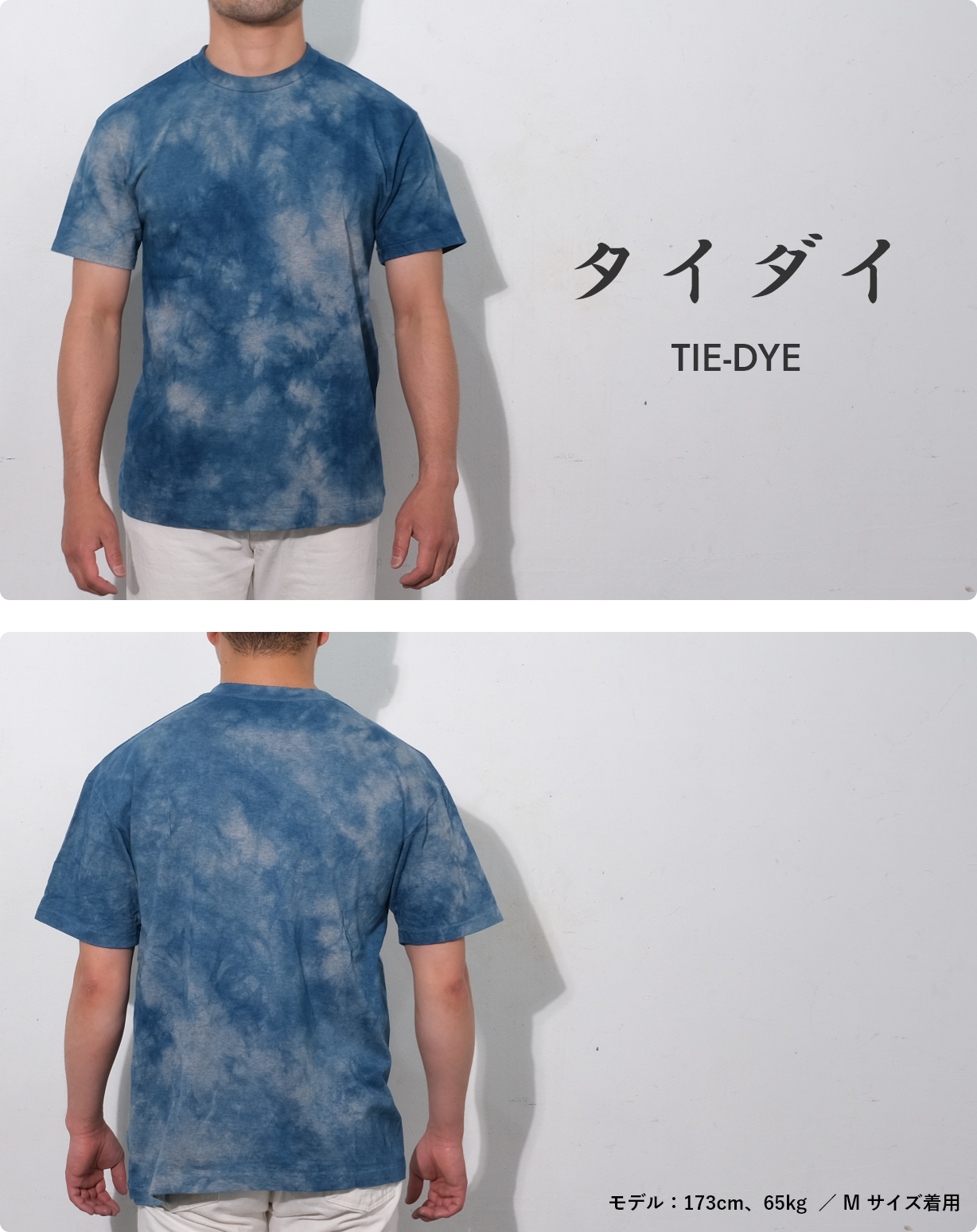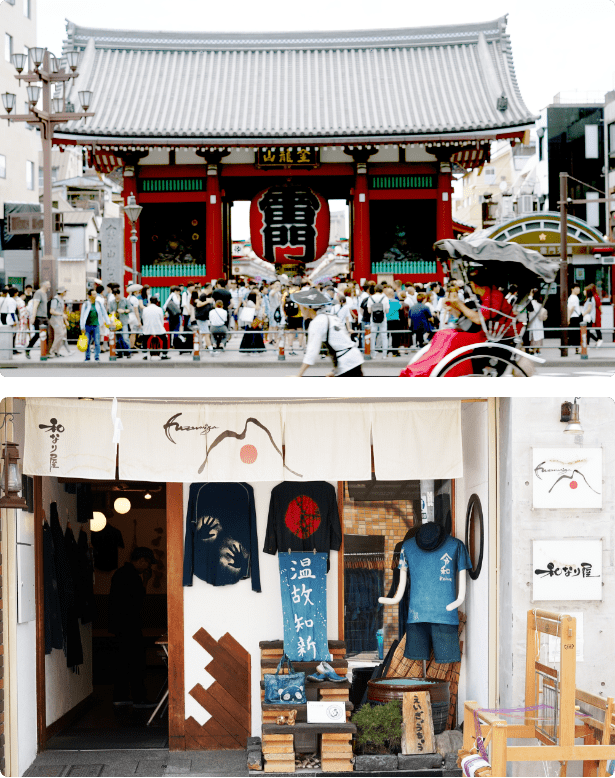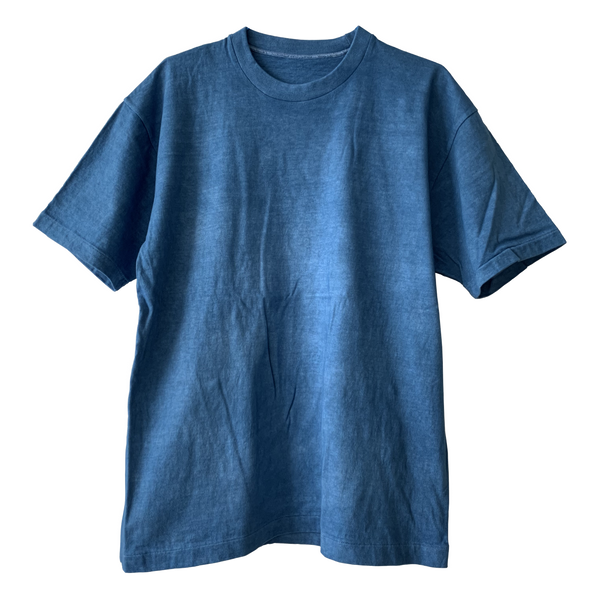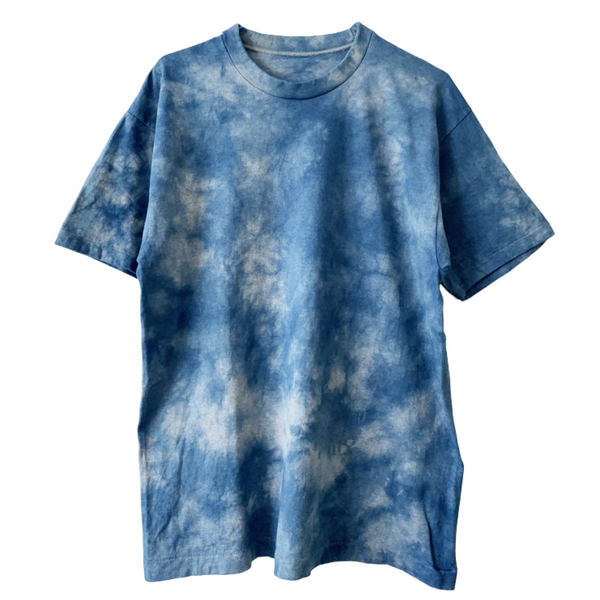Aizome (Japanese Indigo) Baseball Cap and T-shirt

Do you know that there are various traditonal dyeing cultures across Japan, such as Aizome (Japanese indigo), Kakishibu Zome (persimmon tannin dyeing) and Doro Zome (mud dyeing)?
We would like to share this beautiful traditional Japanese dying culture to the world through SOME-ISM.
As our 1st item, we made Aizome classic baseball cap that can be worn all year round.
The cap will fade and change its collar gradually over time, just like jeans.

Aizome is a traditional Japanese hand-dyeing method using organic Persicaria tinctoria. “Ai” means the beautiful indigo blue created by the process as well as leaves of Persicaria tinctoria. “Zome” or "Some" is dyeing in Japanese. In the 700s, Persicaria tinctoria and the Aizome process were introduced into Japan from China.
The unique indigo color created by Aizome is a color that symbolizes Japan and is widely known as "Japan Blue".
Aizome comes in a variety of indigo blues. The shade of blue changes depending on the number of times it is dyed.
For this cap, we adopted Aizome called "Kachiiro" (the third darkest indigo from the left in the below image) which requires many dyeing steps and is a labor-intensive process.

Aizome is said to be a highly functional dye with antibacterial, deodorizing and insect repellent effects.

The back of the 100% cotton white cap made by NEWHATTAN is embroidered with the logo of our brand, SOME-ISM , and finished in brown, one of the darkest blues.
The color is finally completed after the laborious process of soaking it in the dyeing solution and rubbing the dyeing solution well over four times.
The degree of dyeing varies depending on the temperature and humidity , so the number of times the dye is dyed varies depending on the day, and the craftsman's experience allows him to achieve the brown color.
The brim is particularly difficult to dye, so after other parts are dyed to brown, the process is continued until the brim is the same color.

I had samples made many times to get this color.
The cap is difficult to dye and tends to become uneven, so I had to ask the craftsman many times to dye it, which caused some inconvenience, but I was finally able to get the color I was happy with .
As the fabric is washed repeatedly, the indigo dye loses its scum and becomes more vibrant.
The color of the sewing thread is designed to fade, making it your own unique cap .
As you use and wash it, the sewing thread becomes whiter, and the body becomes more vivid in color, which is unique to indigo dyeing, giving it a unique atmosphere.
This is how it changes over the course of 3 months.
You can enjoy the process as the blue becomes brighter overall and the white sewing thread stands out, giving it a vintage look .

The size of the hat is shallow, 11cm high and the longest brim 7cm.
The cap is one size fits all with an adjuster.

The unisex design means it can be worn by both men and women.
It has a slightly curved brim design.
If you like, you can flatten the brim to give it a street feel.
You can wash the cap at home.
Due to the nature of indigo dyeing, the color will bleed initially, so please wash separately from other items. If you wash it in the washing machine 2 to 3 times, the color will not fade easily.
This time, we also have T-shirts dyed with the same dyeing solution as the indigo-dyed baseball caps.
This is also unisex .
The T-shirt is a 100% cotton made-in-Japan T-shirt with a round torso body with no side seams, produced at a long-established factory in Tokyo that has been in business for over 80 years.
In addition, the cuffs and hem feature a ``top and bottom'' pattern that can also be seen on vintage T-shirts. Each and every T-shirt is carefully indigo dyed by craftsmen, just like baseball caps. Because it is hand-dyed, the color and pattern will vary from piece to piece, so please enjoy the warmth of hand-dyed.




*Since each item is dyed and washed by hand, there may be individual differences in the shrinkage rate. There may be a difference of 1-2 cm.



Do you know the difference between indigo dyeing and indigo dyeing, which is dyed to the same blue color as indigo dyeing?

Indigo dyeing is a method of dyeing that uses natural dyes , and it requires a huge amount of time and the skills of skilled craftsmen to dye, and is characterized by the fact that it cannot be mass-produced.
On the other hand, indigo dyeing uses artificial dyes and is mechanized so it can be mass produced.
Therefore, indigo dyeing inevitably results in fewer products than indigo dyeing, making it more rare.
This is also the reason why indigo jeans cost twice as much as indigo jeans.
Indigo dyeing was introduced to Japan from China during the Asuka period (700s) and was used to dye kimonos and local costumes.

Indigo dyeing developed in villages near rivers because large amounts of water were needed to produce good indigo dyeing. In the 1500s, indigo dyeing became a major industry in Tokushima Prefecture, which was blessed with the perfect environment for indigo dyeing.
However, in the early 1900s, the artificial dye indigo was introduced to Japan, and indigo dyeing became sluggish due to its lack of productivity.
After that, during World War II, the government ordered that the fields where indigo was cultivated be converted to edible plants , and indigo cultivation almost disappeared.

Although the indigo dyeing industry was on the verge of extinction, the craftsmen of Tokushima Prefecture secretly continued indigo dyeing, and the indigo dyeing industry has been passed down to the present day.

Although indigo dyeing has overcome the threat of extinction, unfortunately the indigo dyeing industry is in decline due to the trend of mass production and mass consumption of apparel in recent years, as well as a lack of craftsmen.
Indigo dyeing has been passed down for over 1,000 years since the Asuka period , but as the workforce involved in the industry continues to age, the environment has become difficult to create new products.
It is also true that there are many indigo-dyed products that are good as a product, but have a delicate design.
In order to boost the indigo dyeing industry, we believe that in addition to existing indigo dyeing fans, it is necessary for consumers who do not know about indigo dyeing to pick up our products and learn about the benefits of indigo dyeing. .
Utilizing the knowledge and experience we have cultivated in the fashion industry in Japan and around the world , we have begun to create products that will make a variety of customers think, ``This is cool!'' and ``I want to wear it!''
As the first step, we have started this project.
About the craftsmen supporting this project
The baseball cap was dyed by a Japanese dyer in Asakusa.
Wanariya was founded in 2012 to revitalize the indigo dyeing industry, which was in decline.
Wanariya also holds indigo dyeing workshops, which attract many indigo dyeing fans and foreign tourists.
This project was started by requesting Japanese artists who have the same aspirations as us.

The process of making Japan Blue baseball caps
There are a total of 48 types of indigo dyeing, including ``Kame-no-zuki,'' ``Asagi,'' ``Nando,'' ``Ai,'' and ``Kachi-iro.''
Although it takes a lot of effort, we have chosen a brown color that is easy to coordinate in all seasons and allows you to enjoy the change over time .

Indigo dyeing involves fermenting indigo leaves over a long period of time to create ``sukumo'', which is then stood up to create a dye solution.

The dyeing process is also a time-consuming process, as the dyeing is done by hand, in small batches, by craftsmen rather than by machines. We would like to introduce the dyeing process for the baseball caps of this project.

1 . Rinse thoroughly to remove any protein stuck to the fabric.
2 . Dip the cap into the indigo dye solution.

3 . Rub the dye thoroughly so that it penetrates into the thread.
4 . When you take it out of the dyeing solution, it looks dark green at first, but this is the green of the indigo leaves. When you squeeze out the excess dye soaked into the fabric, the dye oxidizes and turns into a beautiful blue color. The more times this process is repeated, the more intense the blue hue becomes.

The baseball cap for this project was dyed over four times to create a brown color, which is darker than indigo.

5 . Once you've achieved the blue you're aiming for, use vinegar to alkalize and soften the color.
Finally, rinse well, dehydrate, and dry in the shade for a day.
This time we introduced indigo dyed products, but there are various clothing dyeing cultures across Japan , such as persimmon tannin dyeing in Kyoto and mud dyeing in Amami Oshima.
These dyeing techniques use natural materials such as plants, so they are characterized by natural colors and have been loved by Japanese people for many years.
However, currently 99.99% of the clothing we wear every day is dyed with synthetic dyes .
Since the late 1800s, the chemicalization of clothing dyes has progressed, leading to an era of mass production and mass consumption, which has placed a huge burden on the environment.
As a result, the United Nations Conference on Trade and Development ranked the fashion industry as the second most polluting industry in the world. In addition, demand for traditional Japanese dyeing techniques decreased dramatically due to the demand for more efficient production.
Coupled with a decline in the labor force in the dyeing industry due to the declining birthrate, Japan's traditional dyeing culture is in decline .
By meeting artisans from various dyeing industries, we are able to witness first-hand the beauty of the delicate colors expressed by the skilled hands of artisans , the efficacy of products obtained through natural dyeing, and the passion of artisans for their techniques. I made it.
At the same time, I learned about the difficult situation that culture and business were in.
After thinking about how we could help preserve this wonderful culture and technology for future generations , we thought that we could help with online marketing and e-commerce, which are areas that artisans are weak at, so we created a `` dyeing platform '' that connects artisans and customers. started.
Through this platform, we would like people not only in Japan but all over the world to know about Japanese dyeing culture, so we named this project in English as " SOME-ISM ", SOME=some=dye, ISM=ism= I named it ism.
Q. Is there color unevenness for each product?
A. Because each item is dyed by hand, there may be slight color variations between each item.
Q. Will the color fade when washed?
A. The color may fade at first, but please enjoy the unique aging process of indigo dyeing.
Q. Is there any effect of indigo dyeing using natural materials?
A. It has been passed down through experience that indigo-dyed clothing has high antibacterial, deodorizing, and insect repellent effects, and is well preserved without being eaten by insects.
*This is a general characteristic of indigo dyeing and has not been tested with this product.















